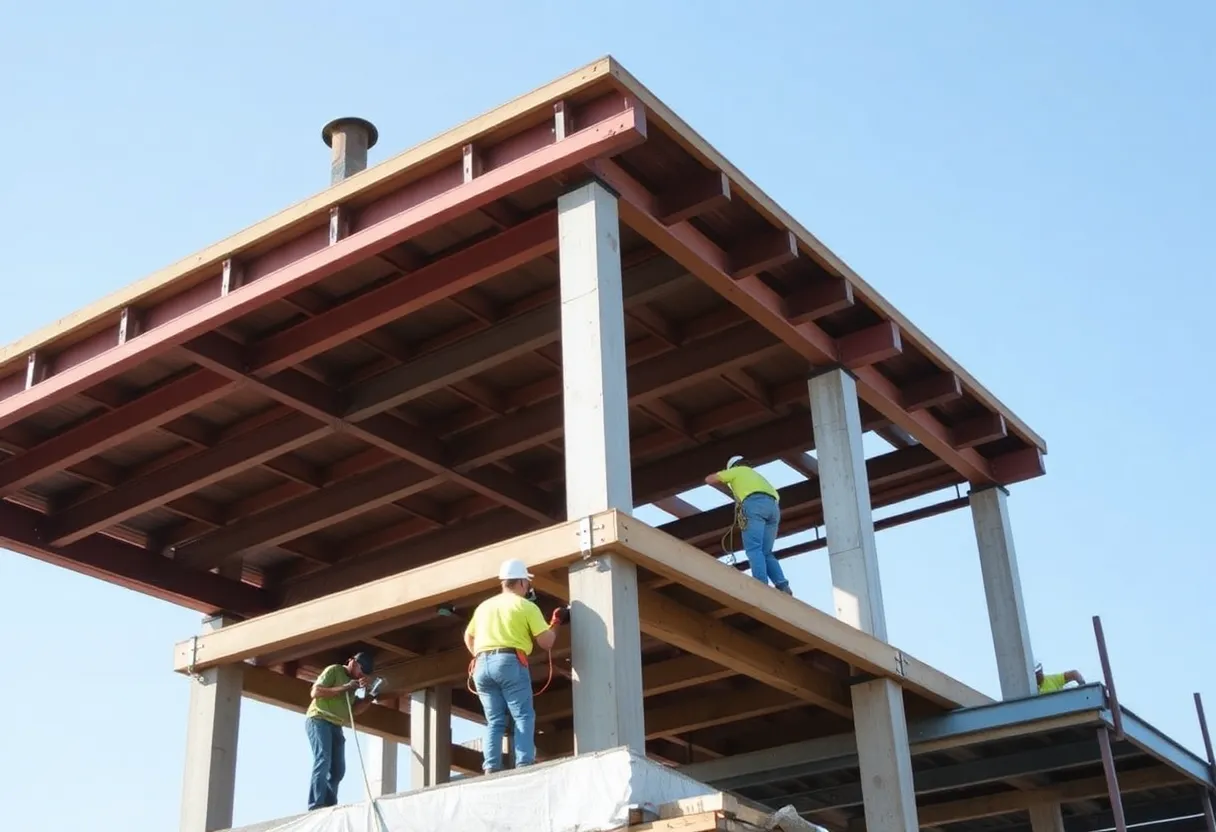China, September 19, 2025
News Summary
Two new academic syntheses reveal what speeds and what blocks BIM adoption in green building projects. A TOE meta-analysis of 62 studies and 11,228 subjects finds compatibility, organizational culture and mimetic pressure as the strongest drivers, with perceived usefulness and ease of use acting as mediators. A separate ISM‑ANP study maps 16 barriers and produces a prioritized action path: policy → management → technical/environmental → economic. Together the papers recommend phased regulatory mandates, financial and R&D support, industry training, and interoperability and management reforms to foster durable BIM uptake in sustainable construction.
New studies map what speeds up and what blocks BIM adoption in green building projects
Compatibility, organizational culture and mimetic pressure emerge as the clearest drivers of building information modeling (BIM) adoption, while a separate study maps 16 barriers and lays out a policy → management → technical → economic action path for BIM use in green buildings. These findings come from two recent academic papers that together synthesize evidence from over 11,000 respondents and apply structured modeling to rank problems and suggest practical policy and management responses.
Top-line findings
The TOE meta-analysis identified compatibility, organizational culture and mimetic pressure as the major TOE drivers of BIM adoption. The pooled evidence covered 11,228 study subjects. The Scientific Reports study identified 16 influencing factors and produced an adjusted hierarchy that points to a clear action path: policy first, then management, then technical/environmental, and finally economic measures.
What the meta-analysis examined
The meta-analysis, titled Revisiting what factors promote BIM adoption more effectively through the TOE framework: A meta-analysis, was authored by Wenshun WANG, Min TAO, Sen GONG, Lingyun MI, Lijie QIAO, Yuguo ZHANG, and Xinyu ZHANG from the Institute of Project Management, School of Mechanics and Civil Engineering and the School of Economics and Management at China University of Mining and Technology. It was supported by the National Social Science Fund Later Funding Project of China and published in Frontiers of Engineering Management (DOI: https://doi.org/10.1007/s42524-025-4056-8).
The study synthesized 62 empirical studies published between 2012 and 2023 across 13 countries. The authors systematically explored key factors promoting BIM adoption and their action mechanisms through the Technology–Organization–Environment (TOE) framework. They also examined moderating effects of national BIM maturity and other contextual factors. The meta-analysis found that perceived usefulness and perceived ease of use mediate the influences of external factors on BIM adoption, and that national BIM maturity moderates the effects of specific pathways in the BIM adoption framework. The authors say the findings provide theoretical and practical support for promoting wider BIM adoption in the AEC industry.
What the Scientific Reports paper mapped
The article titled The application obstacles of BIM technology in green building project and its key role path analysis (Scientific Reports, volume 14, Article number: 30330, DOI: https://doi.org/10.1038/s41598-024-81360-8) set out to identify and analyze application barriers and internal mechanisms of BIM technology in green building projects. The study used an ISM (Interpretive Structural Modeling) approach enhanced by DEMATEL quantification and an ANP (Analytic Network Process) weighting procedure — together referred to as an ISM‑ANP coupling model.
The study analyzed five aspects — technology, economy, management, policy and environment — and identified 16 influencing factors. Initially 47 factors were pulled from literature and narrowed to 16 after expert interviews. Questionnaire surveys yielded 179 effective responses with an effective rate of 75.53%. MATLAB R2023a, Super Decisions and Python 3.8 were used for calculations and weighting. The researchers presented matrices, consistency checks (example judgment matrix C.R. = 0.029 and another with C.R. = 0.070), normalized influence matrices, and a final hierarchical model.
Key structural outcome and the action path
The ISM‑ANP analysis produced a layered model and an overall function rule: Policy factor layer → Management factor layer → Technical and environmental factor layer → Economic factor layer. The first (top) layer (economic factors) consists of exorbitant BIM cost in green buildings (S5), lack of evident investment return (S6), and protracted cost recovery cycle (S7). The study highlights that these economic factors can directly affect BIM application decisions without relying on other factors.
The network model grouped the 16 factors into five categories — economic, technical, environmental, regulatory and policy — and identified nine key factors with importance weight above the average. The authors summarized the key action path as follows (exact wording reproduced from the study): Insufficient government intervention in the application of green building BIM → Insufficient high‑level support and imperfect management system; Insufficient R&D of domestic BIM core technology combined with green building → BIM technology is difficult to innovate and spread in the field of green building; Lack of compound talents → Insufficient economic benefits of green building BIM application → Affecting BIM in green building.
Barriers and evidence cited
The Scientific Reports paper lists barriers including lack of technology integration (for example IoT and energy analysis software), shortage of BIM professionals, high initial investment and weak short‑term economic benefits, interoperability and data‑sharing difficulties, and lack of unified laws and industry standards with data leakage risk. The authors note international research trends moving toward environmental monitoring and green building certification evaluation and cite case results showing measurable savings when BIM is combined with energy or clash-detection workflows, including examples that report collision detection saving up to 10% of contract value and reducing schedules by 7%, and energy-analysis cases that reduced annual energy consumption or air-conditioning load by significant amounts.
Recommendations
The paper recommends that government incorporate BIM application standards into building regulations, mandate BIM for some project types with phased rollouts, provide financial incentives and technical support, and consider a targeted innovation fund and tax incentives. The authors also advise promoting domestic R&D, industry alliances, international cooperation tailored to local needs, and reinforcing BIM teaching and enterprise training. The authors recommend combining policy intervention with internal enterprise adjustments (management, R&D, talent training) to reduce dependence on external incentives and achieve sustainable BIM adoption in green buildings.
Methods and transparency
The Scientific Reports study describes its data sources, expert interviews, questionnaires, matrix construction, thresholding and stratification steps in detail. The paper reports that all data generated or analyzed are included in the published article and supplementary files. The paper is open access under a Creative Commons license and lists funding support from the 15th Graduate Education Innovation Fund of Wuhan Institute of Technology (No. CX2023344).
Why this matters for construction project teams and policymakers
Together, the two studies connect high-level adoption drivers (compatibility, culture, mimetic pressure) with a grounded list of 16 barriers and a prioritized action route: start with coherent policy, strengthen management and incentives, fix technical and interoperability gaps, and then address economic obstacles. The combined evidence suggests that while economic burdens can immediately deter enterprise adoption, durable uptake will depend on policy clarity, institutional support and sustained investment in domestic technology and compound talent.
FAQ
What did the TOE meta-analysis find?
The TOE meta-analysis identified compatibility, organizational culture and mimetic pressure as the major TOE drivers of BIM adoption.
How many subjects did the pooled evidence cover in the meta-analysis?
The pooled evidence covered 11,228 study subjects.
What is the key action path identified by the ISM‑ANP study?
Insufficient government intervention in the application of green building BIM → Insufficient high‑level support and imperfect management system; Insufficient R&D of domestic BIM core technology combined with green building → BIM technology is difficult to innovate and spread in the field of green building; Lack of compound talents → Insufficient economic benefits of green building BIM application → Affecting BIM in green building.
Which factors form the first (top) layer in the ISM‑ANP model?
The first (top) layer (economic factors) consists of exorbitant BIM cost in green buildings (S5), lack of evident investment return (S6), and protracted cost recovery cycle (S7).
What combined recommendation did the authors make?
The authors recommend combining policy intervention with internal enterprise adjustments (management, R&D, talent training) to reduce dependence on external incentives and achieve sustainable BIM adoption in green buildings.
{
“@context”: “https://schema.org”,
“@type”: “FAQPage”,
“mainEntity”: [
{
“@type”: “Question”,
“name”: “What did the TOE meta-analysis find?”,
“acceptedAnswer”: {
“@type”: “Answer”,
“text”: “The TOE meta-analysis identified compatibility, organizational culture and mimetic pressure as the major TOE drivers of BIM adoption.”
}
},
{
“@type”: “Question”,
“name”: “How many subjects did the pooled evidence cover in the meta-analysis?”,
“acceptedAnswer”: {
“@type”: “Answer”,
“text”: “The pooled evidence covered 11,228 study subjects.”
}
},
{
“@type”: “Question”,
“name”: “What is the key action path identified by the ISM‑ANP study?”,
“acceptedAnswer”: {
“@type”: “Answer”,
“text”: “Insufficient government intervention in the application of green building BIM → Insufficient high‑level support and imperfect management system; Insufficient R&D of domestic BIM core technology combined with green building → BIM technology is difficult to innovate and spread in the field of green building; Lack of compound talents → Insufficient economic benefits of green building BIM application → Affecting BIM in green building.”
}
},
{
“@type”: “Question”,
“name”: “Which factors form the first (top) layer in the ISM‑ANP model?”,
“acceptedAnswer”: {
“@type”: “Answer”,
“text”: “The first (top) layer (economic factors) consists of exorbitant BIM cost in green buildings (S5), lack of evident investment return (S6), and protracted cost recovery cycle (S7).”
}
},
{
“@type”: “Question”,
“name”: “What combined recommendation did the authors make?”,
“acceptedAnswer”: {
“@type”: “Answer”,
“text”: “The authors recommend combining policy intervention with internal enterprise adjustments (management, R&D, talent training) to reduce dependence on external incentives and achieve sustainable BIM adoption in green buildings.”
}
}
]
}
Key features at a glance
| Feature | Details |
|---|---|
| TOE meta-analysis | Title: Revisiting what factors promote BIM adoption more effectively through the TOE framework: A meta-analysis; 62 studies (2012–2023); 11,228 study subjects; 13 countries; published in Frontiers of Engineering Management (DOI: https://doi.org/10.1007/s42524-025-4056-8) |
| Major TOE drivers | Compatibility, Organizational culture, Mimetic pressure; perceived usefulness and perceived ease of use act as mediators |
| Scientific Reports study | Title: The application obstacles of BIM technology in green building project and its key role path analysis; Scientific Reports volume 14, Article 30330 (2024); DOI: https://doi.org/10.1038/s41598-024-81360-8 |
| Method | ISM improved by DEMATEL combined with ANP (ISM‑ANP coupling), supported by expert interviews and 179 effective questionnaires |
| Core outcome | 16 influencing factors grouped into five categories; final hierarchy: Policy → Management → Technical & Environmental → Economic; top economic factors are S5, S6, S7 |
| Policy recommendations | Include BIM standards in regulations, phased mandates, financial incentives, R&D support, training, industry alliances, and potential innovation funds or tax incentives |
| Data & tools | MATLAB R2023a, Super Decisions, Python 3.8; data and supplementary files included in the publication |
Deeper Dive: News & Info About This Topic
Additional Resources
- Newswise: Revisiting what factors promote BIM adoption more effectively through the TOE framework
- Wikipedia: Building information modeling
- Scientific Reports: The application obstacles of BIM technology in green building project and its key role path analysis
- Google Search: BIM green building barriers
- Nature Scientific Reports: 2025 study on BIM adoption (s41598-025-06662-x)
- Google Scholar: TOE framework BIM adoption
- AEC Magazine: BIM — the Chinese way
- Encyclopedia Britannica: Building Information Modeling
- ScienceDirect: Article S0926580524000372 (BIM adoption research)
- Google News: BIM adoption green buildings
Author: Construction FL News
The FLORIDA STAFF WRITER represents the experienced team at constructionflnews.com, your go-to source for actionable local news and information in Florida and beyond. Specializing in "news you can use," we cover essential topics like product reviews for personal and business needs, local business directories, politics, real estate trends, neighborhood insights, and state news affecting the area—with deep expertise drawn from years of dedicated reporting and strong community input, including local press releases and business updates. We deliver top reporting on high-value events such as the Florida Build Expo, major infrastructure projects, and advancements in construction technology showcases. Our coverage extends to key organizations like the Associated Builders and Contractors of Florida and the Florida Home Builders Association, plus leading businesses in construction and legal services that power the local economy such as CMiC Global and Shutts & Bowen LLP. As part of the broader network, including constructioncanews.com, constructionnynews.com, and constructiontxnews.com, we provide comprehensive, credible insights into the dynamic construction landscape across multiple states.





